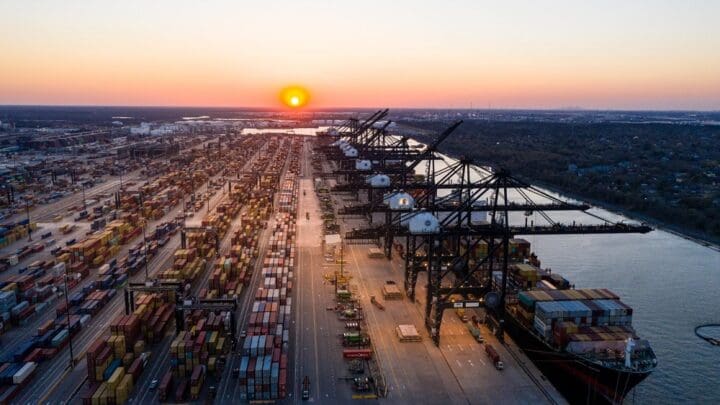
Bordered to the south by the US Gulf states of Texas and Louisiana, Arkansas’ beverage industry comprises a range of manufacturers from craft breweries and distilleries to regional branches of multinational suppliers.
One such firm, described as one of the world’s leading premium spirits producers, operates a complex global supply chain spanning dozens of countries.
In the US, the company distils a large number of its products in Arkansas which then have to be transported to the Barbours Cut and Bayport Container Terminals at Port of Houston for loading onto vessels and exported to overseas markets.
However, transporting liquor and other alcoholic beverages requires navigating a myriad of state-level rules and regulations, procuring specialised equipment, and access to a pool of drivers that maintain the permits necessary to transport alcohol-based products legally to secure maritime locations.
Challenges & needs
Because the shipper moves alcoholic liquid in bulk, rather than bottled or canned form, it requires ISO tank containers. Unlike a typical dry box container, tank containers need specialised ISO tank chassis for transport. But these chassis are less common, and at times, undergo significant shortages.
Due to the large volumes and complex logistics needs, the multinational firm found it challenging to maintain an adequate equipment and driver base for its drayage operations. So, it went looking for a highly specialised solution, but this entailed particular requirements.
Specialised service: ISO tank transport is inherently a specialised service, which was compounded by the firm’s need for drayage services, including power only moves.
Specialised drivers: Safely piloting an ISO tank loaded chassis requires additional training, protocols, and skills. Tank containers have a higher centre of gravity than standard dry vans, and the movement of the liquid inside the tanks during transport can affect the handling of the tractor and chassis. Drivers must have experience in properly accelerating and braking the vehicle to prevent liquid ‘surge’, ie, excessive movement of the liquid within the tank which can cause a driver to lose control or destabilise the vehicle. Drivers must also obtain and maintain a tanker endorsement which certifies that they have been trained to transport bulk liquids properly.
Permits and approvals
These restrictions are compounded by an array of specialised permits and approvals needed before the tank and truck can hit the road.
Hazardous Materials (HazMat) Endorsement: Drivers with liquid transport experience and hazmat certification are limited in supply and can be like finding a needle in a haystack.
Transportation Worker Identification Credential: Commonly known as a ‘TWIC card’, this credential is required by the Maritime Transportation Security Act for workers that need access to secure areas of maritime facilities and vessels. TSA conducts a security threat assessment (background check) to determine a person’s eligibility and issues the credential. Without a TWIC card, drivers cannot access ports for pickups or deliveries.
Vessel Approval: The underlying carrier’s SCAC code needs to be approved by the vessel in order for drivers to pick up from, or deliver to, a vessel. This can get complicated as the drinks company might have as many as 20 vessels in use at any given time, and the driver needs to be approved by each one.
Custodian Bond: Custodian Bonds, also known as Activity Code 2 Custodian of Bonded Merchandise Bonds, are required for operations which carry or hold merchandise not yet entered into the commerce of the US, for export or entry at a later time or place. Third party logistics providers (3PLs) serving the firm’s needs are required to hold this bond, which essentially makes the 3PL liable for taxes associated with the transported goods.
Sheer solution
To help navigate this complex supply chain maze, Sheer Logistics, headquartered in Chesterfield, Missouri, created a dedicated drayage programme specifically tailored to the multinational firm’s highly specialised needs.
To build capacity, Sheer leased ISO tank chassis, ultimately creating a dedicated pool of more than 50 chassis, while the Sheer team also sourced a third-party yard to store the chassis when not in use.
Sheer required a yard with a crane capable of lifting tanks off the chassis, and having sourced such a yard began partnering with it to design a solution that also provides inspection and maintenance of the chassis, including tyres, brakes, brake lights, etc.
Leveraging its extensive carrier base in the region Sheer also identified carriers whose drivers maintained the necessary skills and credentials, including ISO tank hauling experience, HazMat endorsements and TWIC cards. The logistics operator then advised the carrier base on how to secure vessel approvals to allow for access to the ports and obtained the required Custodian Bond.
Sheer provides dedicated, on-demand service to the drinks company, handling drayage and power-only moves to and from Arkansas to Barbours Cut and Bayport as well covering as intra-Houston moves when needed. This service is exceptionally time critical; when the shipper charters a vessel, it can cost as much as US$75,000 per day.
So, Sheer provides expedited and team service to meet these tight deadlines, having delivered as many as 100 loads in less than a week – earning the Sheer team ‘mission critical’ status from its customer.
Describing Sheer as “100 percent mission critical to us”, the beverage firm’s director of logistics, commented: “The communication that Sheer does is something I wish my other brokers did. The level of customer service has spoken volumes.”